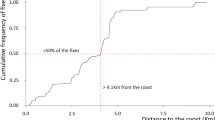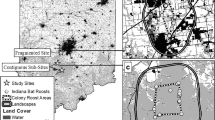Abstract
Many European migratory bat species hibernate in large hollow trees, a decreasing resource in present day silviculture. Here, we report on the importance of man-made hibernacula to support trans-boundary populations of noctule bats (Nyctalus noctula), a species that performs seasonal long distance movements throughout Europe. In winter, we surveyed nine bat roosts (eight artificial and one natural) in Germany and collected small tufts of fur from a total of 608 individuals. We then measured the stable isotope ratios of the non-exchangeable hydrogen in fur keratin and estimated the origin of migrants using a refined isoscape origin model that included information on expected flight distances and migration directions. According to the stable isotope signature, 78 % of hibernating bats originated from local populations. The remaining 22 % of hibernacula occupants originated from distant populations, mostly from places in northern or eastern countries such as Sweden, Poland and Baltic countries. Our results confirm that many noctule bats cross one or several political borders during migration. Data on the breeding origin of hibernating noctule bats also suggest that artificial roosts may not only be important for local but also for distant populations. Protection of natural and artificial hibernacula in managed forests may support the trans-boundary populations of migratory bats when hollow trees are scarce in managed forests.




Similar content being viewed by others
References
Agostinelli C, Lund U (2011) R package ‘circular’: Circular Statistics version 0.4-3. https://r-forge.r-project.org/projects/circular/. Accessed 10 Oct 2013
Blohm T, Heise G (2008) Großer Abendsegler Nyctalus noctula Schreber, 1774 in: Naturschutz und Landschaftspflege in Brandenburg – Beiträge zu Ökologie, Natur- und Gewässerschutz. Natursch Landschaftspfl Brandenbg 17:153–160
Boehm SM, Wells K, Kalko EKV (2011) Top-down control of herbivory by birds and bats in the canopy of temperate broad-leaved oaks Quercus robur. PLoS ONE 6:e17857
Boonman M (2000) Roost selection by noctules Nyctalus noctula and Daubenton’s bats Myotis daubentoni. J Zool 251:385–389
Bowen GJ, Wassenaar LL, Hobson KA (2005) Global application of stable hydrogen and oxygen isotopes to wildlife forensics. Oecologia 143:337–348
Ciechanowski M (2005) Utilization of artificial shelters by bats Chiroptera in three different types of forest. Folia Zool 54:31–37
Crampton LH, Barclay RMR (1998) Selection of roosting and foraging habitat by bats in different-aged aspen mixed wood stands. Conserv Biol 12:1347–1358
Cryan PM, Bogan MA, Rye RO, Landis GP, Kester CL (2004) Stable hydrogen isotope analysis of bat hair as evidence for seasonal molt and long-distance migration. J Mammal 85:995–1001
Delignette-Muller ML, Pouillot R, Denis J-B, Dutang C (2013) Fitdistrplus: help to fit of a parametric distribution to non-censored or censored data. R package version 2.0-12
Dietz C, von Helversen O, Nill D (2009) Handbook of bats of Europe and Northwest Africa. A C Books, Seattle
Erzberger A, Popa-Lisseanu A, Lehmann GUC, Voigt CC (2011) Potential and limits in detecting altitudinal movements of bats using stable hydrogen isotope ratios of fur keratin. Acta Chiropt 13:431–438
Evans D (2012) Building the European Union’s Natura 2000 network. Nat Conserv 1:11–16
Fernandez C, Azkona P (1996) Influence of forest structure on the density and distribution of the white-backed woodpecker Dendrocopos leucotos and black woodpecker Dryocopus martius in Quinto Real (Spanish western Pyrenees). Bird Study 43:305–313
Furmankiewicz J, Kucharska M (2009) Migration of bats along a large river valley in southwestern Poland. J Mammal 90:1310–1317
Ghanem SJ, Voigt CC (2012) Increasing awareness of ecosystem services provided by bats. Adv Study Behav 44:279–302
Gossner MM, Lachat T, Brunet J et al (2013) Current near-to-nature forest management effects on functional trait composition of saproxylic beetles in beech forests. Cons Biol 27:605–614
Gunnarsson G, Latorre-Margelef N, Hobson KA et al (2012) Disease dynamics and bird migration—linking mallards Anas platyrhynchos and subtype diversity of the Influenca A virus in time and space. PLoS ONE 7:e35679
Heise G, Blohm T (2012) Arbeit mit Fledermauskästen—sinnvoll oder nicht? Nyctalus 17:226–239
Hijmans RJ, van Etten J (2012) Raster: Geographic analysis and modelling with raster data. R package version 2.0-12
Hijmans RJ, Williams E, Vennes C (2012) Geosphere: spherical trigonometry. R package version 1.2-28. http://CRAN.R-project.org/package=geosphere
Hobson KA (1999) Tracing origins and migration of wildlife using stable isotopes: a review. Oecologia 120:314–326
Hutterer R, Ivanova T, Meyer-Cordes C, Rodrigues L (2005) Bat migrations in Europe—a review of banding data and literature. Natursch Biol Vielf 28:41–43
Jung K, Kaiser S, Bohm S, Nieschzlze J, Kalko EKV (2012) Moving in three dimensions: effects of structural complexity on occurance and activity of insectivorous bats in managed forest stands. J Appl Ecol 49:523–531
Kouki J, Väänänen A (2000) Impoverishment of resident old growth forest bird assemblages along an isolution gradient of protected areas in eastern Finland. Ornis Fennica 77:145–154
Legendre P (2008) lmodel2: Model II Regression. R package version 1.6-3
Marra PP, Hobson KA, Holmes RT (1998) Linking winter and summer events in a migratory bird by using stable-carbon isotopes. Science 282:1884–1886
Meschede A, Heller K-G (2000) Ökologie und Schutz von Fledermäusen in Wäldern. Schriftenreihe Landschaftspfl Natursch 66:374
Mikusiński G, Angelstam P (1998) Economic geography, forest distribution, and woodpecker diversity in Central Europe. Conserv Biol 12:200–208
Moning C, Muller J (2009) Critical forest age thresholds for the diversity of lichens, mollusks and birds in beech (Fagus sylvatica) dominated forests. Ecol Indica 9:922–932
Niemela J, Young J, Alard D et al (2005) Identifying, managing and monitoring conflicts between forest biodiversity conservation and other human interests in Europe. Forest Policy Econ 7:877–890
Norris DR, Marra PP, Kyser TK, Sheery TW, Ratcliffe L (2004) Tropical winter habitat limits reproductive success on the temperate breeding grounds in a migratory bird. Proc R Soc Lond B 271:59–64
Ossa G, Kramer-Schadt S, Peel AJ, Scharf AK, Voigt CC (2012) The movement ecology of the straw-colored fruit bat, Eidolon helvum, in sub-Saharan Africa assessed by stable isotopes ratios. PLoS ONE 7:e37101
Ostermann OP (1998) The need for management of nature conservation sites designated under Natura 2000. J Appl Ecol 35:968–973
Petit E, Mayer F (1999) Male dispersal in the noctule bat Nyctalus noctula: where are the limits? Proc R Soc Lond B 266:1717–1722
Popa-Lisseanu AG, Soergel K, Luckner A et al (2012) A triple isotope approach to predict breeding origins of European bats. PLoS ONE 7:e30388
R Development Core Team (2009) R: a language and environment for Statistical Computing. R Foundation for statistical computing, Vienna, Austria. ISBN 3-900051-07-0. http://www.R-project.org. Accessed 10 Oct 2013
Robbins CS, Sauer JR, Greenberg RS, Droege S (1989) Population declines in North American birds that migrate to the neotropics. Proc Nat Acad Sci USA 86:7658–7662
Ruczyński I, Bogdanowicz W (2005) Roost cavity selection by Nyctalus noctula and L. leisleri Vespertilionidae, Chiroptera in Białowiża primeval forest, eastern Poland. J Mammal 85:921–930
Russo D, Cistrone L, Garonna AP, Jones G (2010) Reconsidering the importance of harvested forests for the conservation of tree-welling bats. Biodiv Conserv 19:2501–2515
Rydell J, Bach L, Dubourg-Savage M-J, Green M, Rodriguez L, Hedenström A (2010) Bat mortality at wind turbines in northwestern Europe. Acta Chiropterol 12:261–274
Schmidt A (2010) Zum Überwinterungsverhalten des Abendseglers Nyctalus noctula in Ostbrandenburg. Nyctalus 15:223–234
Sherry TW, Holmes RT (1996) Winter habitat quality, population limitation, and conservation of Neotropical-nearctic migrant birds. Ecology 77:36–48
Steffens R, Zöphel U, Brockmann D (2004) 40 Jahre Fledermauskartierungszentrale Dresden—methodische Hinweise und Ergebnisübersicht. Sächsisches Landesamt für Umwelt und Geologie
Studds CE, McFarland KP, Aubry Y, Rimmer CC, Hobson KA, Marra PP, Wassenaar LI (2012) Stable-hydrogen isotope measures of natal dispersal reflect observed population declines in a threatened migratory songbird. Div Distr 18:919–930
Sullivan AR, Bump JK, Kriger LA, Peterson RO (2012) Bat-cave catchment areas: using stable isotopes (δD) to determine the probable origins of hibernating bats. Ecol Appl 22:1428–1434
Venables WN, Ripley BD (2002) Modern applied statistics with S, 4th edn. Springer, New York. ISBN 0-387-95457-0
Viana DS, Santamaria L, Michot TC, Figuerola J (2013) Allometric scaling of long-distance seed dispersal by migratory birds. Am Nat 181:649–662
Voigt CC, Popa-Lisseanu A, Niermann I, Kramer-Schadt S (2012) The catchment area of wind farms for European bats: a plea for international regulations. Biol Conserv 153:80–86
Voigt CC, Helbig-Bonitz M, Kramer-Schadt S, Kalko EKV (2013) The third dimension of bat migration: Elevational movements of Miniopterus natalensis at Mount Kilimanjaro. Oecologia. doi:10.1007/s00442-013-2819-0
Young J, Watt A, Nowicki P, Alard D, Clitherow J, Henle K, Johnson R, Laczko E, McCracken D, Matouch S, Niemela J, Richards C (2005) Towards sustainable land use: identifying and managing the conflicts between human activities and biodiversity conservation in Europe. Biodiv Conserv 14:1641–1661
Acknowledgments
We would like to Anja Luckner from the IZW Stable Isotope Laboratory for isotope analyses. AGP was supported by a postdoc fellowship from the Alexander von Humboldt Stiftung. The project was approved by the Animal care and ethics committee of the Leibniz Institute for Zoo and Wildlife Research.
Author information
Authors and Affiliations
Corresponding author
Additional information
Mateusz Ciechanowski, Péter Estók, Florian Gloza-Rausch, Tamás Görföl, Matthias Göttsche, Carsten Harrje, Meike Hötzel, Tobias Teige and Reiner Wohlgemuth in alphabetical order
Rights and permissions
About this article
Cite this article
Voigt, C.C., Lehnert, L.S., Popa-Lisseanu, A.G. et al. The trans-boundary importance of artificial bat hibernacula in managed European forests. Biodivers Conserv 23, 617–631 (2014). https://doi.org/10.1007/s10531-014-0620-y
Received:
Accepted:
Published:
Issue Date:
DOI: https://doi.org/10.1007/s10531-014-0620-y




